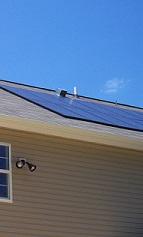Scope
Provide an architectural drawing and riser diagram for the homeowner showing the planned location for future solar hot water and photovoltaic system components. Space requirements and layout for solar water heating and photovoltaic system components should be taken into account early in the design process.
See the Compliance Tab for links to related codes and standards and voluntary federal energy-efficiency program requirements.
Description
A renewable energy-ready home (RERH) is one that is built with the wiring and plumbing conduit and other components in place to facilitate the future installation of solar photovoltaic panels and/or solar water heating panels. Some energy-efficiency programs, like the U.S. Department of Energy’s DOE Zero Energy Ready Home Program, require homes to be renewable-energy ready.
When constructing a home to be renewable energy ready, develop architectural drawings and plumbing riser diagrams that summarize the installed system equipment (pipe chase, etc.). The drawings should accurately represent the installed elements of the system during the final inspection of the house; these drawings should be included in the homeowner education packet.
To meet the requirements of the DOE Zero Energy Ready Home program, the builder should provide a basic architectural drawing to the homeowner summarizing where the equipment is located within the house (see Figure 1). The builder should also provide the homeowner with a plumbing riser detail of the solar water heating system components. This diagram should have sufficient detail to clearly identify:
- Pipe chase size and type
- Length of chase from the designated roof/attic termination point to the utility room
- Designated location and allotted space size of future hot water tank
- Designated location and allotted space size of pump package mounting panel.
How to Create an Architectural Drawing for Solar Hot Water:
- Create a plumbing riser diagram like the one shown in Figure 1 that includes all of the following components of the solar hot water system:
- Proposed location and square footage for the solar hot water panel array on the roof (preferably directly above the utility room)
- Pipe chase from attic to utility room with size, type, and location clearly indicated.
- Utility room space that contains
- 3’ x 3’ x 7’ extra space for a solar hot water heater
- a 3’ x 2’ plywood panel mounted on the wall adjacent to the solar hot water tank location for balance of system components
- a solar bypass valve on the cold inlet to the existing water heater
- access to the plumbing and wiring chase that extends to the proposed solar thermal panel array on the roof.
Success
Ensure adequate utility room size and location for solar water heating and photovoltaic system components early in the house design process.
Confirm with local code officials early in the design process what steps are needed to guarantee that installation of solar water heating panels will meet with local codes, homeowner's association covenants, and historic district regulations. See the article on building codes and regulations related to solar water heating systems at Energy.gov for additional information.
Climate
The DOE Zero Energy Ready Home PV-Ready Checklist (Revision 07) is required only under the following condition related to climate (See the Compliance Tab for other exceptions):
- Location, based on zip code, has at least 5 kWh/m2/day average daily solar radiation based on annual solar insolation using the PVWatts online tool. See map below.
In climates where freezing temperatures are likely to occur, a closed-loop anti-freeze system with a heat exchanger will keep outdoor water pipes from freezing and bursting.

Training
Compliance
More
More Info.
Access to some references may require purchase from the publisher. While we continually update our database, links may have changed since posting. Please contact our webmaster if you find broken links.
The following authors and organizations contributed to the content in this Guide.
Sales
Solar DHW Ready Home =

Solar hot water systems use energy from the sun to heat water for use in the home. The easiest time to prepare a home for the installation of these systems is during design and construction. A solar hot water-ready home does this by providing plumbing lines from the attic to the hot water heater, chases for wiring, documentation that the roof is designed to support the extra weight of the solar thermal panels, adequate roof space for the solar collector array that is not shaded, and adequate space in the utility room for an additional solar hot water tank, pumps, and controls.
